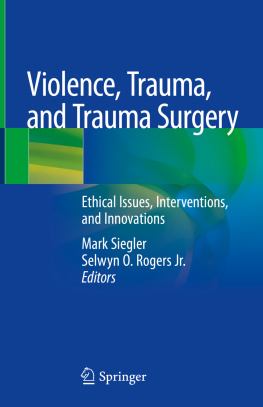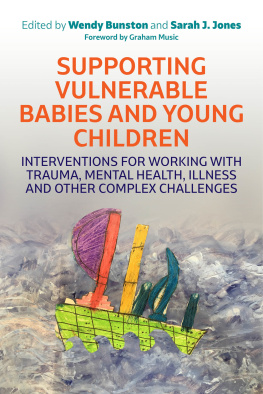Safeguarding Children Living
with Trauma and Family Violence
Best Practice in Working with Children Series
Edited by Brigid Daniel, Professor of Social Work, Department of Applied
Social Science, University of Stirling
The titles in the Best Practice in Working with Children series are written for the multi-agency professionals working to promote childrens welfare and protect them from harm. Each book in the series draws on current research into what works best for children, providing practical, realistic suggestions as to how practitioners in social work, health and education can work together to promote the resilience and safety of the children in their care. Brigid Daniel is Professor of Social Work in the Department of Applied Social Science at the University of Stirling. She is co-author of several textbooks and practice resources on child care and protection. She was a member of the multi-disciplinary team that carried out a national ministerial review of child protection practice in Scotland.
also in the series
Safeguarding Children and Schools
Edited by Mary Baginsky
Foreword by Brigid Daniel
ISBN 978 1 84310 514 5
Child Neglect
Practice Issues for Health and Social Care
Edited by Julie Taylor and Brigid Daniel
Foreword by Olive Stevenson
ISBN 978 1 84310 160 4
Safeguarding Children in Primary Health Care
Edited by Julie Taylor and Markus Themessl-Huber
Foreword by Brigid Daniel
ISBN 978 1 84310 652 4
Safeguarding Children Living with
Trauma and Family Violence
Evidence-Based Assessment,
Analysis and Planning Interventions
Arnon Bentovim, Antony Cox,
Liza Bingley Miller and Stephen Pizzey
Foreword by Brigid Daniel
Jessica Kingsley Publishers
London and Philadelphia
Crown copyright material is reproduced with the permission of the controller of HSMO and the Queens Printer in Scotland
First published in 2009
by Jessica Kingsley Publishers
73 Collier Street
London N1 9BE, UK
and
400 Market Street, Suite 400
Philadelphia, PA 19106, USA
www.jkp.com
Copyright Arnon Bentovim, Antony Cox, Liza Bingley Miller and Stephen Pizzey 2009
Foreword copyright Brigid Daniel 2009
All rights reserved. No part of this publication may be reproduced in any material form (including photocopying or storing it in any medium by electronic means and whether or not transiently or incidentally to some other use of this publication) without the written permission of the copyright owner except in accordance with the provisions of the Copyright, Designs and Patents Act 1988 or under the terms of a licence issued by the Copyright Licensing Agency Ltd, Saffron House, 610 Kirby Street, London EC1N 8TS . Applications for the copyright owners written permission to reproduce any part of this publication should be addressed to the publisher.
Warning: The doing of an unauthorised act in relation to a copyright work may result in both a civil claim for damages and criminal prosecution.
Library of Congress Cataloging in Publication Data
Safeguarding children living with trauma and family violence : evidence-based assessment, analysis and planning interventions / Arnon Bentovim ... [et al.] ; foreword by Brigid Daniel.
p. cm. -- (Best practice in working with children)
Includes bibliographical references and index.
ISBN 978-1-84310-938-9 (pb : alk. paper) 1. Children and violence. 2. Family violence--Psychological aspects. 3. Children--Services for. 4. Social work with children. I. Bentovim, Arnon.
HQ784.V55S23 2009
362.76'20973--dc22
2008051578
British Library Cataloguing in Publication Data
A CIP catalogue record for this book is available from the British Library
ISBN 978 1 84310 938 9
eISBN 978 1 84642 938 5
Contents
Foreword
Brigid Daniel
List of Tables
List of Figures
Foreword
This latest book in our series exemplifies our aim to offer support for Best Practice in Working with Children. Based on contemporary research evidence and rooted in a consistent theoretical framework the book offers systematic and detailed guidance on how to help traumatized children.
As a result of significant policy development, and associated training, professionals who encounter children now have greater awareness of the symptoms and indications of abuse and neglect. Teachers, doctors, nurses, psychologists, adult mental health workers, substance misuse workers and others are now much more sensitive to signs of unmet childhood developmental needs. They are also much clearer about the need for a timely response to prevent significant harm to ongoing development and the key role they can play in ensuring that the professional network is mobilized. However, increased awareness is of no benefit unless it leads to children getting the help that is needed.
All too often our systems stall or run into the sand once the initial process of identification of abuse or neglect is completed. Once the priority of immediate safety is addressed children and their parents can often feel as if they are left adrift with little support. But it is at this point that the right kind of professional support can make the crucial difference for the trajectory of a childs ongoing development. Certainly, many abused and neglected children can be supported effectively by non-abusing parents, carers, wider family and friends. But, equally, there are many children whose lives in the short, and longer, term will be transformed by sensitive and appropriate therapeutic support, tailored to their needs.
The book addresses trauma and its impact upon children. Trauma is often associated with individual events or disasters and their aftermath and the book provides a detailed and sophisticated analysis of trauma and helps to explain the impact of traumatic incidents of physical or sexual abuse. But the book takes the subject much further by exploring the impact of more chronic circumstances. This detailed attention to the climate of care is timely and essential. There is now an accumulation of evidence about the devastating impact of growing up under enduringly stressful conditions.
Recent policy developments have also stressed the importance of comprehensive assessment and planning. Practitioners often struggle with making sense of all the information that can be collated from a range of sources. And, again, there is no point to assessment activity if it does not lead to a purposeful plan for intervention. Using detailed worked examples, this book takes the Department of Health triangle as the starting point and augments it with dynamic new concepts to assist with assessment and analysis. Crucially, there is detail about how to consider the interaction of factors across different domains and how to analyse the implications for intervention.
For decades our systems have been preoccupied with investigation; this book takes us beyond investigation and re-asserts the importance of offering children considered and effective therapeutic support.
Brigid Daniel,
University of Stirling
Introduction
This book focuses on working with children and families living in a climate of trauma and family violence. This includes families where there may be recurrent patterns of violence between adults; verbal, sexual or physical violence involving children; extensive abuse of one or more children, or multiple forms of maltreatment at various phases of development, causing physical, sexual and emotional harm and impairment of health and development.





